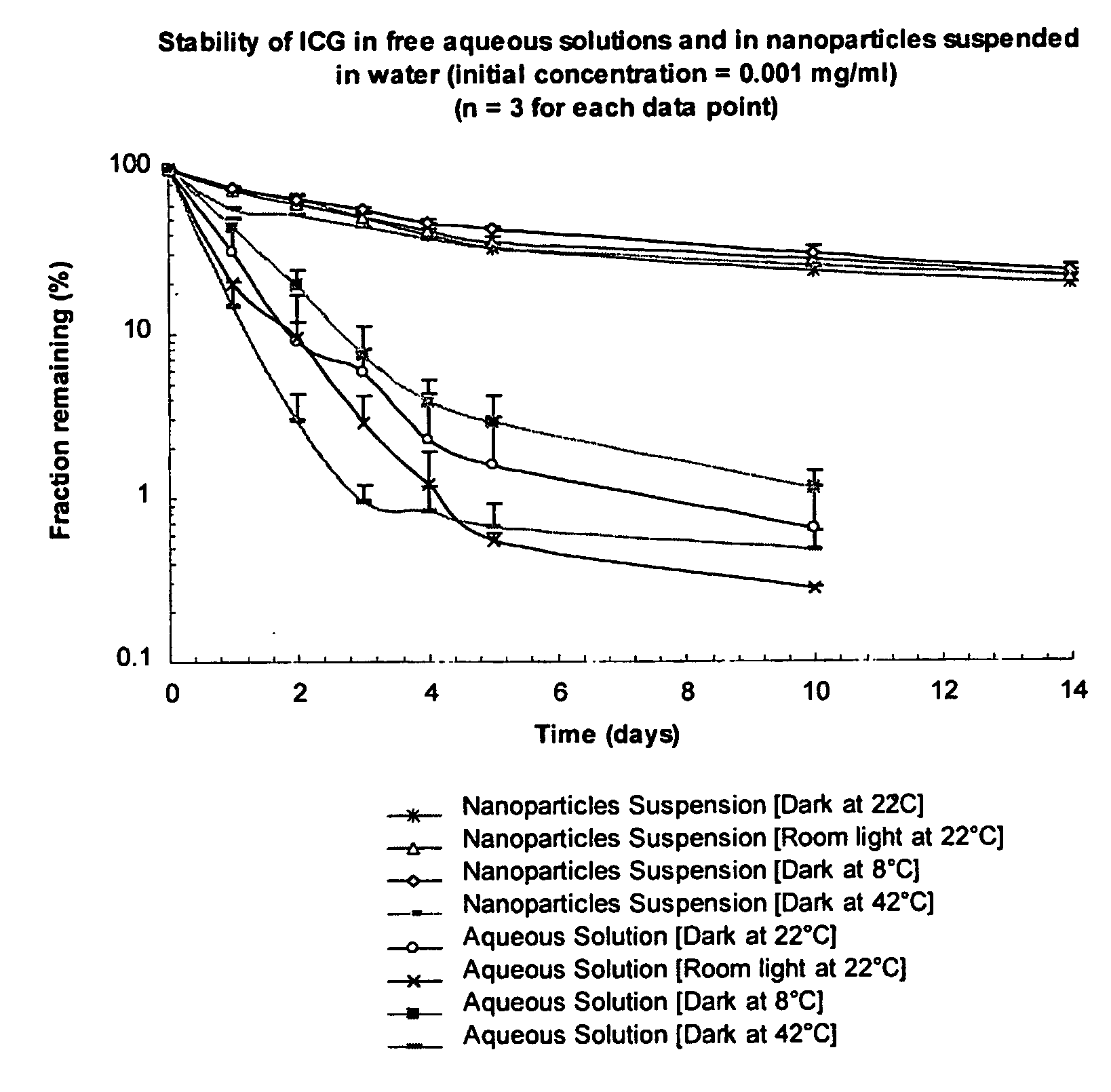Nanoparticle based stabilization of ir fluorescent dyes
- Summary
- Abstract
- Description
- Claims
- Application Information
AI Technical Summary
Benefits of technology
Problems solved by technology
Method used
Image
Examples
example 1
Preparation of IR-125 Loaded PLGA Nanoparticles
Materials:
[0059] Poly(dl-lactic-co-glycolic acid) (PLGA) 50:50 and Polyvinyl alcohol (PVA) 88%-89% hydrolyzed were purchased from Sigma (Sigma Chemical Co., St. Louis, Mo.). Indocyanine green (IR-25, laser grade) was obtained from Fisher Scientific (Fisher Scientific Inc., Pittsburgh, Pa.). All organic chemicals and solvents were of reagent grade. Distilled water is filtered by 0.22μ syringe filter (Syrfil-MF Whatman Inc., Clifton, N.J.) before use in the preparation process.
Preparation of IR-125 Loaded PLGA Nanoparticles:
[0060] 1. Nanoparticles were prepared by modified spontaneous emulsification solvent diffusion method. Briefly, PLGA (800 mg) was dissolved in 16 mL Acetonitrile to form a PLGA solution and IR-125 was dissolved in Methanol to make 0.125 mg / mL IR-125 solution.
[0061] 2. Also, PVA (4 g) was added to about 100 mL distilled water to form 4% w / v PVA aqueous solution. This aqueous PVA solution is then filtered using 0....
example 2
Relative Stabilities of Indocyanine Green (ICG) in Aqueous Solutions Compared with ICG in Nanoparticles Prepared According to the Method Described in Example 1
[0068] ICG solution of 1 μg / mL was prepared by dissolving 10 mg ICG in 100 mL distilled water and further diluted 100 times in distilled water. About 50 mg ICG nanoparticles were suspended in 100 mL distilled water to obtain 1 μg / mL ICG concentration. The two samples were then placed into several transparent centrifuge tubes and placed at different conditions. At the prefixed time points, the peak fluorescent intensity of these samples was measured at excitation wavelength of 786 nm. The fractions of ICG that remained were calculated by comparing the fluorescent intensity with the initial fluorescent intensity as shown in FIG. 1. Atomic Force Microscopic images of ICG (IR-125) loaded PLGA nanoparticles are shown in FIG. 2. Evaluation of particle size through Atomic Force Microscopy of ICG (IR-125) loaded PLGA nanoparticles is...
example 3
Intracellular Uptake of Indocyanine Green (ICG), by C-33A Cancer Cell line, when Incubated with ICG Solution and ICG Loaded Nanoparticles
[0069] Intracellular uptake of Indocyanine green (ICG), by C-33A cancer cell line, when incubated with ICG solution and ICG loaded nanoparticle suspension is shown in FIG. 4. The nanoparticles used were prepared according to the method described in Example 1.
[0070] ICG solution of 50 μM was prepared by dissolving ICG in the cell culture medium and this solution was further diluted in the cell culture medium to get concentrations from 0.00022 to 50 μM. About 10 mg ICG nanoparticles were suspended in 10 mL cell culture medium to obtain 1 mg / mL nanoparticle suspension equivalent to 0.022 μM ICG concentration. This suspension was then further diluted to get the nanoparticle suspension of 0.00022 to 0.011 μM ICG concentrations. For the intracellular uptake studies, cells were seeded in 6-well cell culture plates at the concentration of 2×105 in 4 ml g...
PUM
 Login to View More
Login to View More Abstract
Description
Claims
Application Information
 Login to View More
Login to View More - R&D
- Intellectual Property
- Life Sciences
- Materials
- Tech Scout
- Unparalleled Data Quality
- Higher Quality Content
- 60% Fewer Hallucinations
Browse by: Latest US Patents, China's latest patents, Technical Efficacy Thesaurus, Application Domain, Technology Topic, Popular Technical Reports.
© 2025 PatSnap. All rights reserved.Legal|Privacy policy|Modern Slavery Act Transparency Statement|Sitemap|About US| Contact US: help@patsnap.com



